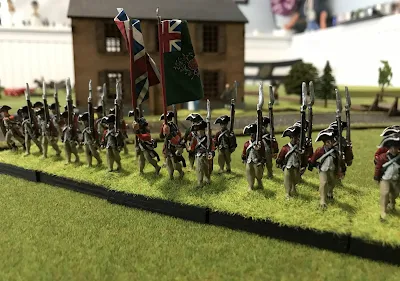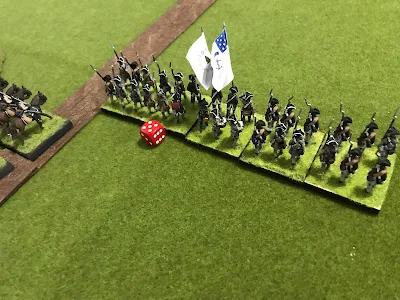Here is the entire Loyalist Brigade ready for the table top. These regiments all fought together at the Battle of Hobkirk Hill in April 1781. They provide a colorful and needed reinforcement to my Crown Forces Army.
Wednesday, August 5, 2020
Loyalist Brigade 1780-81
Sunday, August 2, 2020
South Carolina Royalist Regiment 1781
The South Carolina Royalists were raised in May 1778 under Col Alexander Innis. They fought at the siege of Savannah 1779. In 1780 they were part of the garrison at Ninety-Six. In 1781 they were constantly engaged against Marion’s brigade and also fought at at Hobkirks Hill. They were a long serving, hard fighting regiment.
Although raised as an infantry battalion by the summer of 1781 they were converted to a legion type organization. From a nine company infantry regiment eight companies were equipped as cavalry, and one infantry company. In this configuration they were more mobile and equipped to fight the American partisans. They reverted back to infantry companies before being moved to to St Augustine, November 1782 . It appears the regiment had many black soldiers in its ranks. When disbanded in October 1783 the white soldiers were sent to settle in Nova Scotia. Black soldiers were combined with other men from various loyalist corps and sent to the West Indies to serve there as Carolina Corps.
I have painted the regiment in red coats faced yellow with overalls and round hats. There is not a lot of documentation for this regiment so it's a educated guess based on what is out there. Here is what we do know; Early in their history they had red coats faced white. Wiederhold’s 1783 Almanack states that the South Carolina Royalists had red coats, but no facing and button colors are indicated. The 1783 New York List mentions “Red Coat — Yellow Lappel Variety button hole,” for the South Carolina Royalists. it is also possible they might have had blue jackets for a short time. I went with yellow facings as info not have a yellow faced regiment! Not very historical but colorful!
There is no evidence for a regimental colors, but that has not stopped me from giving them a set. These are based on British regulation colors for the period.
Saturday, August 1, 2020
King's American Regiment 1781 (4th American Regiment)
The King's American Regiment was raised in New York in December 1776 by Colonel Edmund Fanning. It took part in the 1777 attacks on Fort Clinton and Fort Montgomery, the 1780 Siege of Charleston, the 1781 raids on Newport and Richmond, Virginia, and the 1781 Campaigns in South Carolina, Georgia and East Florida. The regiment was brought into the American Establishment, on March 7, 1781 and renamed the "4th American Regiment". The regiment became part of the British Establishment in 1782 (possibly as the "110th Regiment of Foot" ) and was disbanded in Canada in 1783. During much of their history they fought along side the New York Volunteers at Fort Montgomery and Fort Clinton 1777 and again later at Hobkirk Hill 1781
The regiments uniform for much of their history appears to be red coats faced green (later faced blue). Officers lace was gold. Although there is no mention of regimental colors I have not let that stop me and gave them a set based on existing British patterns.
Thursday, July 30, 2020
Brigadier For Loyalist Brigade 1781
Fife and Drum miniatures added a new British command figure to their catalog. Unlike the others he is wearing a round hat which makes it a nice change from those in regulation head gear. I thought he should command my new Loyalist Brigade so here is. A very well done figure which was a joy to paint.
Tuesday, July 21, 2020
The Battle of Blastoff Bridge 1781
For some reason I have never refought any of the classic old school war game scenarios I have so enjoyed reading over the years. Inspired by a recent posting on the Fife and Drum miniatures forum I have decided to jump in and try my hand. But instead of the Seven Years War period I am transporting it to the American Rev War.
The objective of the game is to control the bridge. The river is shallow and can be crossed except 12 inches on each side of the bridge. The house blocks line of sight only. Woods block line of sight and provide cover for troops within it. The hill provides extra range to troops firing from its top. Once a side has lost more then fifty per cent of its troops it must withdraw off the board. Rules used are "The Whites of Their Eyes" by Steve Haller.
Continental Forces:
11th Continental Regiment
9th Continental Regiment
Lee's Legion Dragoons
Rifle Regiment
Hamilton 's Battery (medium gun)
Loyalist Forces:
Volunteers of Ireland
New York Volunteers
British Legion Dragoons
British Legion Infantry
Royal Artillery (medium gun)
Both sides entered the game with a double move distance from their corners. I did this to get into action faster. The Loyalist commander rolled high so would get the first move throughout the game. He decided to send his cavalry towards the bridge supported by the Volunteers of Ireland. The Legion light infantry, New York Volunteers and artillery headed towards the ford opposite the woods.
The Continental Forces took a different track. The Artillery headed straight to the hill to get a dominant position. The rifles headed straight towards the protection of the woods while the line infantry took position on either side of the hill. Let the enemy come to them and destroy them through firepower. Lee's dragoons waited in reserve to be useful.
Fighting occurred by the ford and woods. The Legion Infantry and NYV crossed the river to close with the enemy. Using their superior range the rifles picked away at the legion infantry. (Note: rifles have longer range but can only fire every other turn. Usually a player will fire half his rifles each turn to maintain a constant rate of fire.)
At this point the Loyalist Forces pressed forward to the attack. The British Legion Infantry charged into the woods and after a short sharp fight they drove the riflemen out.
But the Legion cavalry was less successful. They crossed the river, formed line and charged the infantry in front of them. The 11th Continental stood their ground and saw them off with ease. The Legion dragoons charged back as fast as they could. For good measure the 11th fired a volley into the retreating dragoons which put them under 50% and they routed off the table.
Both the 9th Continental and New York Volunteers traded volleys at close range with The Royal Artillery adding their firepower. This was too much form the 9th who failed morale and routed.
In the woods the riflemen passed their morale check and used a split move to get a better shot at the legion infantry. ( In these rules light troops can move part off their movement, fire and then move the remaining portion of their movement. A neat little rule that helps light troops act like light troops.) Close range fire caused the Legion to fail morale and routed back. A staff officer raced to try and rally them which was unsuccessful.
But the damage was done and now the rifles were able to out flank the New York Volunteers. In addition Lee's Legion dragoons formed up facing the Volunteers ready to charge. With the Volunteers of Ireland being slowly reduced by artillery and musket fire things did not look good for the Loyalists. His cavalry and light infantry gone and one of his line regiments reduced the commander ordered his forces to retire to fight another day. Both sides had fought well but the Continental 's had had a better plan. All in all a fun game and one could play in any number of periods. Perhaps the Crimean War next?
Subscribe to:
Comments (Atom)
































